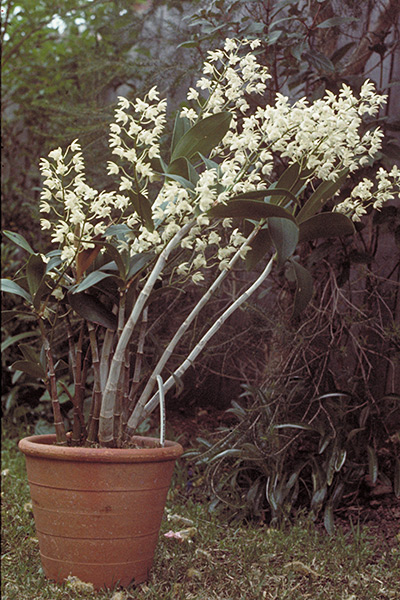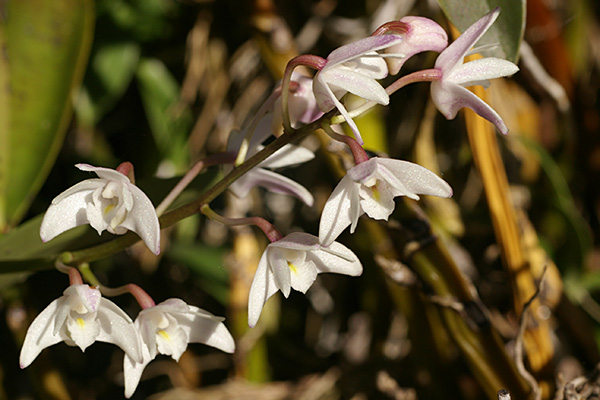General Description:
Dendrobium is a large genus with around 1400 species spread throughout Asia and the Pacific. Australia has about 56 species, many of which are cultivated. Considerable hybridization has been carried out within the genus to produce improved horticultural forms and a number of naturally occurring hybrids are also in cultivation.
Major taxonomic revision of the Dendrobium group has occurred in recent years with many species being transferred to new genera. Some of these changes have been reasonably widely accepted (eg Dockrillia) while the status of others is less certain.
Dendrobium x delicatum, although once regarded as a pure species is now accepted as a natural hybrid between D.kingianum and D.tarberi (the latter also being known as D.speciosum var.hillii). Both D.kinganum and D.tarberi have been transferred to the genus Thelychiton by some authorities (which would also result in the transfer of D. x delicatum to that genus). However, the earlier name is retained here in accordance with the Australian Plant Census.
D. x delicatum is a lithophyte (growing on rocks). It is variable in habit, which is to be expected as its parents are also variable in habit. The pseudobulbs are 20 to 35 cm long, thickest near the base and tapering towards the apex. There are usually 2 to 5 thick leaves at the top of each pseudobulb, the leaves being 75 to 175 mm long. Flowers occur on 250 mm long stems in clusters of up to 14 or more flowers. They are usually pure white to cream with purple dots on the labellum and are often sweetly scented. Flowers are seen from late winter to spring.
D. x delicatum is popular in cultivation and is easy to grow in tropical to temperate climates. It can be grown on branches of trees or on rocks where it receives nutrients through the break down of leaf litter that accumulates around its root system. While the plant is establishing its root system, it may need to be fixed into position by wire or twine. Eventually new roots will form which will grip the substrate firmly. The plant should not be planted directly into soil as the root system is not adapted to constant moisture. It can also be grown as a container plant in a coarse medium such as pinebark chips but it may require frequent re-potting. Glasshouse cultivation is not necessary except in colder climates as the plant is frost sensitive. It should not be grown in dense shade or flowering will be discouraged. Application of liquid fertilizer during the growing season (spring – summer) will promote healthy growth. Watering should be kept to a minimum during winter.
Plants can usually be obtained through specialist Australian orchid nurseries. The plant can be propagated by division of the clump but propagation by seed requires specialist treatment which is not really practical except for true orchid enthusiasts.

Dendrobium x delicatum
Photo: Brian Walters

Dendrobium x delicatum
Photos: Brian Walters
 Australian Native Plants Society (Australia)
Australian Native Plants Society (Australia)